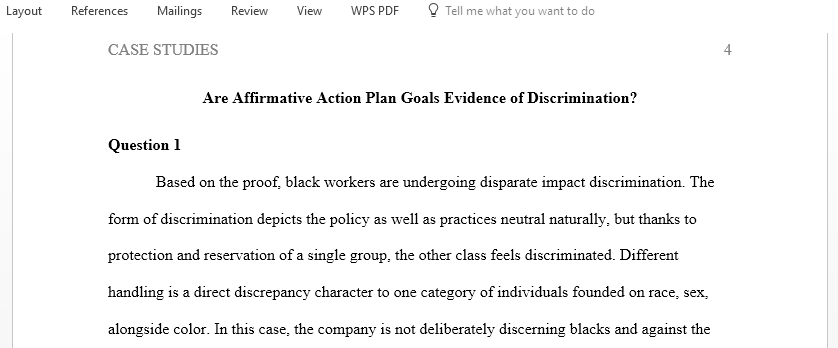Are Affirmative Action Plan Goals Evidence of Discrimination
Case Study
Are Affirmative Action Plan Goals Evidence of Discrimination?
Xerox Corporation manufactures and markets copy machines and also provides facilities management services through Xerox Business Services (XBS). In the 1990s, Xerox started a Balanced Workforce Initiative (BWF) that involved the publication of specific affirmative action goals for each job and each salary grade level within the company. This plan was started in an effort to ensure proportional representation of all racial and gender groups throughout the company. The BWFs were based on government labor force data and established annually. Part of the annual performance evaluation for managers was how well they met the desired racial and gender compositions for their locations. In one instance, BWF reports compiled for the Houston office indicated that black employees were overrepresented and white employees were under-represented. Over a period of five years, steps were taken to reduce the percentage of black employees in the office in an effort to correct this imbalance. Six black employees filed suit against Xerox stating that they were denied promotion opportunities in the Houston office even though they were qualified for the jobs into which they wanted to be promoted. They also indicated that they felt the BWF data adversely affected their opportunity for advancement. Each plaintiff had a slightly different situation, but they collectively raised concerns that included denial of promotions, salary disparities, hostile work environment, and termination.
Questions
- Based on the evidence presented, has discrimination occurred? If so, which type of discrimination (i.e., disparate treatment, disparate impact, both)? If you aren’t sure, what questions would you want to have answered to make your determination?
- Which party (plaintiffs or defendant) has the burden of proof in this case? What defense could Xerox offer if the plaintiffs make a case of discrimination? Discuss how successful you think the company will be at defending its actions.
- Could Xerox have achieved the same goals in a less discriminatory manner? If so, how? If not, why not?
- How do the actions in this case differ from the intent and recommended practices for affirmative action?
Case study
Globalization at Levi Strauss
Blue jeans are a legendary component of American culture. They were created in the United States in 1873, when Levi Strauss patented the riveted denim jeans that proved so successful among customers that they launched an entire industry. Yet, the one company that has perhaps been most synonymous with blue jeans—Levi Strauss—doesn’t actually make its blue jeans in the United States.
In the late 1990s and early part of this decade, Levi Strauss undertook a substantial shift in the location of its manufacturing operations. In 1997, Levi Strauss closed 11 plants and laid off 7,400 employees to cut excess production. In 1999, Levi’s announced a large-scale layoff of almost 6,000 jobs and the closing of more factories in Georgia, North Carolina, Virginia, Texas, Tennessee and Arkansas in an effort to move production to foreign facilities. Over time, the layoffs and the closing continued.
Once a mainstay of U.S. manufacturing, plants in areas such as San Antonio, San Francisco, El Paso, and Brownsville, were closed, and by 2004, Levi Strauss had shut its domestic operations and moved production facilities to foreign countries such as Mexico and China. Costs were a major factor for this decision. What might cost $6.67 to make in the United States costs about $3.00 in Mexico and $1.50 in China. While Levi Strauss was reluctant to move these jobs, it faced a competitive market operating with lower costs and lower prices.
Questions
- How did the four environmental factors discussed in this chapter influence Levi’s decision to move its manufacturing outside the United States?
- How would you evaluate this decision from a business perspective? What about from an ethical perspective?
- Assume that you are an employee working for Levi Strauss and are assigned to the management team in one of the manufacturing facilities in Mexico. What differences would you anticipate in terms of how you manage your Mexican employees versus how you manage employees located in the United States?
Answer preview for Are Affirmative Action Plan Goals Evidence of Discrimination

Access the full answer containing 870 words by clicking the below purchase button.
